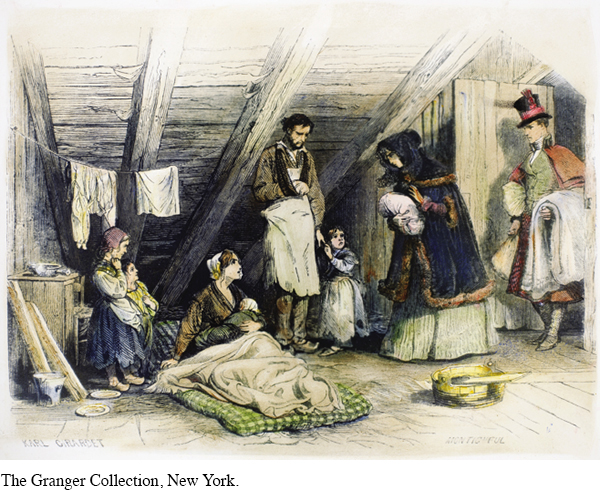The American Promise: Printed Page 324
The American Promise: A Concise History: Printed Page 338
BEYOND AMERICA’S BORDERS
Global Prosperity in the 1850s
By the 1850s, the U.S. economy had achieved a remarkable economic transformation. In 1801, when president-
In the 1850s, some countries in the world produced more total goods and services than the United States. But since they had much larger populations than the United States, they produced much less per capita. For example, China produced huge quantities of goods and services, roughly four times more than the United States. But since the Chinese population was about twenty times greater than that of the United States, the per capita production of China was only about one-
In other words, if all the goods and services in China and the United States in 1850 had been shared equally by the people who lived in each country, each person in China would have had only one-
Like China, African countries were about one-
The American economy surpassed even the two largest countries of western continental Europe, France and Germany. Both countries, like the United States, had started to industrialize, making them far more prosperous than most of the world. But they lagged behind the United States in per capita production. Germany’s per capita production was about 80 percent of that of the United States; France’s was about 90 percent.
Great Britain, the most prosperous country in the world in 1850, surpassed the per capita production of the United States by 30 percent. With a population of 21 million, slightly fewer than the 23 million residents of the United States, Britain produced a whopping 45 percent of the world’s manufactured goods.
Many factors contributed to Britain’s economic leadership, but three were especially important. First, most people in Britain had moved to towns and cities by 1850. Rural folks made up only 22 percent of Britain’s population, compared to 85 percent of the U.S. population. Many urban dwellers worked in industries that, in general, were more productive than agriculture, boosting British output. Second, wages were relatively high in Britain, giving manufacturers a big incentive to replace costly labor with machinery. Although machinery required capital outlays to set up and maintain, it was far more efficient and tireless than wageworkers.
Manufacturers in both Britain and the United States had similar incentives to industrialize, but British producers did so first and with far greater effectiveness than did those in the United States, in large measure because Britain had a cheap and nearly inexhaustible source of energy—

Questions for Analysis
Summarize the Argument: In 1850, how did U.S. prosperity compare to that of the rest of the world?
Analyze the Evidence: Why did Britain have the world’s leading economy in 1850? What accounted for Britain’s success compared to the United States?
Consider the Context: What does the pattern of global prosperity and poverty in 1850 suggest about the motivations for immigration to the United States?
Recognize Viewpoints: To what extent is per capita production a misleading measure of prosperity? Can you think of better measures?
Ask Historical Questions: How did the comparative economic prosperity of the United States influence the experiences and ideas of Americans during the 1850s?